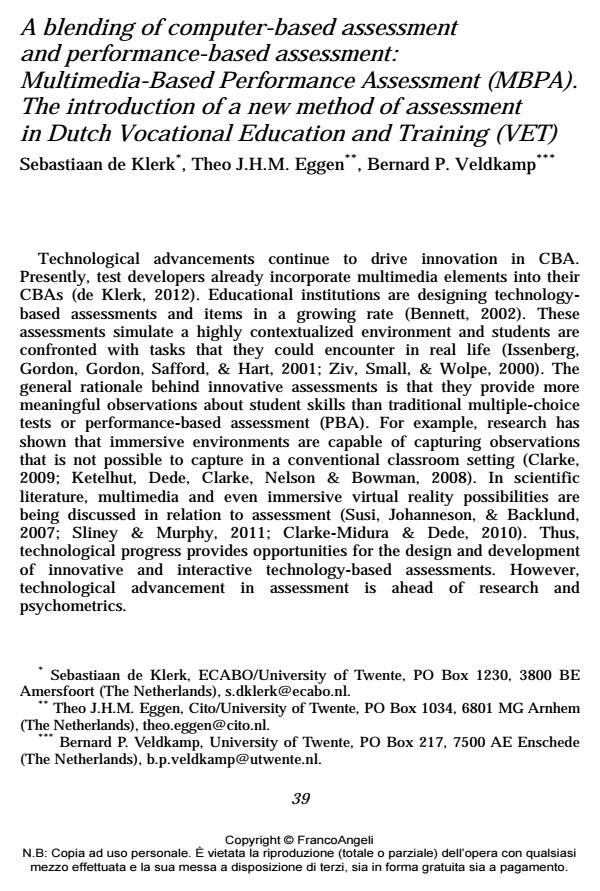A blending of computer-based assessment and performance-based assessment: Multimedia-Based Performance Assessment (MBPA). The introduction of a new method of assessment in Dutch Vocational Education and Training (VET)
Titolo Rivista CADMO
Autori/Curatori Sebastiaan de Klerk, Theo J.H.M. Eggen, Bernard P. Veldkamp
Anno di pubblicazione 2014 Fascicolo 2014/1
Lingua Inglese Numero pagine 18 P. 39-56 Dimensione file 1085 KB
DOI 10.3280/CAD2014-001006
Il DOI è il codice a barre della proprietà intellettuale: per saperne di più
clicca qui
Qui sotto puoi vedere in anteprima la prima pagina di questo articolo.
Se questo articolo ti interessa, lo puoi acquistare (e scaricare in formato pdf) seguendo le facili indicazioni per acquistare il download credit. Acquista Download Credits per scaricare questo Articolo in formato PDF

FrancoAngeli è membro della Publishers International Linking Association, Inc (PILA)associazione indipendente e non profit per facilitare (attraverso i servizi tecnologici implementati da CrossRef.org) l’accesso degli studiosi ai contenuti digitali nelle pubblicazioni professionali e scientifiche
Innovation in technology drives innovation in assessment. Since the introduction of computer-based assessment (CBA), a few decades ago, many formerly paper-and-pencil tests have transformed in a computer-based equivalent. CBAs are becoming more complex, including multimedia and simulative elements and even immersive virtual environments. In Vocational Education and Training (VET), test developers may seize the opportunity provided by technology to create a multimedia-based equivalent of performance-based assessment (PBA), from here on defined as multimediabased performance assessment (MBPA). MBPA in vocational education is an assessment method that incorporates multimedia (e.g. video, illustrations, graphs, virtual reality) for the purpose of simulating the work environment of the student and for creating tasks and assignments in the assessment. Furthermore, MBPA is characterized by a higher amount of interactivity between the student and the assessment than traditional computer-based tests. The focal constructs measured by MBPA are the same as are currently assessed by performance-based assessments. Compared to automated delivery of item-based tests, MBPA realizes the full power of ICT. In the present article we will therefore discuss the current status of MBPA, including examples of our own research on MBPA. We provide an argument for the use of MBPA in vocational education too.
Parole chiave:Assessment in vocational education and training, performance-based assessment, computer-based assessment, multimedia-based performance assessment.
- Computational Psychometrics: New Methodologies for a New Generation of Digital Learning and Assessment Jessica Andrews-Todd, Robert J. Mislevy, Michelle LaMar, Sebastiaan de Klerk, pp.45 (ISBN:978-3-030-74393-2)
- Psychometric analysis of the performance data of simulation-based assessment: A systematic review and a Bayesian network example Sebastiaan de Klerk, Bernard P. Veldkamp, Theo J.H.M. Eggen, in Computers & Education /2015 pp.23
DOI: 10.1016/j.compedu.2014.12.020 - Plagiarism detection in students’ programming assignments based on semantics: multimedia e-learning based smart assessment methodology Farhan Ullah, Junfeng Wang, Muhammad Farhan, Sohail Jabbar, Zhiming Wu, Shehzad Khalid, in Multimedia Tools and Applications /2020 pp.8581
DOI: 10.1007/s11042-018-5827-6 - The design, development, and validation of a multimedia-based performance assessment for credentialing confined space guards Sebastiaan de Klerk, Bernard P. Veldkamp, Theo J. H. M. Eggen, in Behaviormetrika /2018 pp.565
DOI: 10.1007/s41237-018-0064-x
Sebastiaan de Klerk, Theo J.H.M. Eggen, Bernard P. Veldkamp, A blending of computer-based assessment and performance-based assessment: Multimedia-Based Performance Assessment (MBPA). The introduction of a new method of assessment in Dutch Vocational Education and Training (VET) in "CADMO" 1/2014, pp 39-56, DOI: 10.3280/CAD2014-001006